1. Meet Intel's fastest multi-core chips
Intel has released its flagship 18-core, behemoth Core i9-7980XE and its slightly smaller sibling, the 16-core Core i9-7960X. Officially, disclosed all the way back in May, the new processors are launching now to impend AMD Threadripper firestorm.
Designed for mega-taskers and multi-core lovers, Intel says that its Core X-series products are the company's "Most Powerful, Most Scalable" desktop processors to date. When you consider they scale from a quad-core part with only 16 PCI Express lanes, all the way on up to a monolithic 18-core chip with 44 integrated PCIe lanes, scalable certainly does come to mind.
The 18-core Core i9-7980XE and 16-core Core i9-7960X both feature HyperThreading, hence the support for 36 and 32 processing threads with these 18 and 16 core processors. They both have the same number of PCIe lanes (44), support for quad-channel DDR4 at official speeds of up to 2666MHz, 165 watt TDPs, and similar support for an array of Intel technologies. Both chips also leverage the same LGA 2066 socket and X299-chipset as well. Their differences are spotted in their base and turbo clocks, total cache, and their max TJunction temperature.
It's also worth noting that Intel's Virtual Raid On CPU (VROC) feature-which allows you to link several M.2 NVMe SSDs in a bootable virtual RAID either via on-board M.2 slots, or via an expansion card-remains locked to RAID 0 out of the box. Those wanting to run other types of RAID need to purcahse a small VROC dongle for around $100.
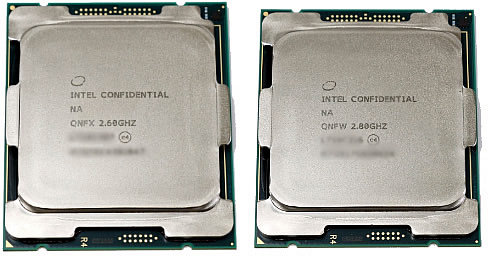
The Core i9-7980XE and Core i9-7960X are both based on Intel‚??s Skylake-X microarchitecture. and the same 14nm FinFET Skylake-SP architecture of Intel's Xeon server and workstation chips. The architecture features a new AVX-512 instruction set (up from 256-bit-wide AVX) and a new cache hierarchy. Intel has also dramatically redesigned the way each core exchanges data with another, introducing a mesh topology.
It is interesting to see how Intel has used this mesh topology to construct its multicore CPUs compared to AMD. Intel uses its mesh topology to create a single, monolithic die that contains all 16 cores. Theoretically, since all the cores are on the same die‚??and because Intel can run the mesh at a solid clock speed, regardless of memory timings-data exchanged between each core is quick and consistent.
The drawback is scalability. The more cores Intel crams into a single die, the larger it becomes, the more costly it is to produce, and the hotter it gets. By contrast, AMD has opted for a multichip module (MCM) design for Threadripper. Theadripper is essentially two eight-core Ryzen dies (which are actually just two four-core dies) thrust together onto the same CPU package, and linked together via AMD's Infinity Fabric tech.
While Infinity Fabric does rely on fast DDR4 memory clocks to function at its best, the benefit of the MCM design is that it's far easier to scale to more cores while maintaining reasonable thermals and clock speeds.
|
Core i9-7980XE |
Core i9-7960X |
Core i9-7900X |
Core i7-7820X |
| Architecture |
Skylake-X |
Skylake-X |
Skylake-X |
Skylake-X |
| Cores /threads |
18C / 36T |
16C / 32T |
10C / 20T |
8C / 16T |
| Base clock |
2.6GHz |
2.8GHz |
3.3GHz |
3.6GHz |
| TB 2.0 clock |
4.2GHz |
4.2GHz |
4.3GHz |
4.3GHz |
| TB 3.0 clock |
4.4GHz |
4.4GHz |
4.5GHz |
4.5GHz |
| L3 |
24.75MB |
22MB |
13.75MB |
11MB |
| PCIe 3.0 lanes |
44 lane |
44 lane |
44 lane |
28 lane |
| Supported memory |
DDR4-2666 x 4ch |
DDR4-2666 x 4ch |
DDR4-2666 x 4ch |
DDR4-2666 x 4ch |
| TDP |
165W |
165W |
140W |
140W |
| Unlocked |
Yes |
The Core i9-7980XE (Extreme Edition) sits atop the Core X Series line-up. It is packing 18 Skylake-X cores (36 threads with HyperThreading) with a base clock of 2.6GHz and max Turbo 2.0 and Turbo Boost Max 3.0 frequencies of 4.2GHz and 4.4GHz, respectively. The Core i9-7980XE has 24.75MB of shared L3 cache, 1MB of L2 cache per core, and a TDP of 165W
The Core i9-7960X's details are essentially same. Although it has fewer cores, its base clock is 200MHz higher than the flagship Core i9-7980XE. The chip is matching AMD's flagship Threadripper 1950X.
According to the tests we performed using CINEBENCH R15 / CPU, the turbo frequency for the Core i9-7960X tops at 4GHz.
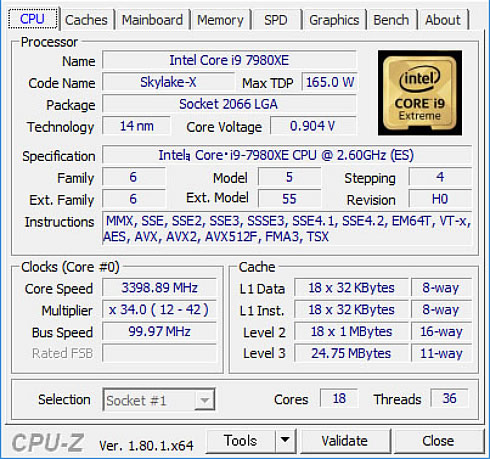

Here is out testbed:
|
Skylake-X |
Ryzen Threadripper |
| CPU Cooler |
Corsair H115i |
| Motherboard |
ROG STRIX X299E ASUSTeK GAMING
(UEFI Version 0802) |
ASUSTeK PRIME X399-A |
| memory |
Ballistix BLT2K8G4D26AFTA Crucial
(PC4-21300 DDR4 SDRAM 8GB √? 2) x 2 sets |
| Graphics card |
STRIX-GTX1070 ROG-O8G-GAMING
|
| SSD |
Samsung SM961 Samsung |
| Power supply |
Seasonic SS-660XP (80 PLUS Platinum) |
| OS |
Microsoft Windows 10 Pro (1703) |
2. Cinebench R15, PCMark 10
We start our benchmarks with the Cinebench R15, in both single -threaded and multi-threaded tasks. Also ntice that we tested both Local and Distributed settings for the AMD chips. AMD has introduced a new memory access mode that you can toggle either in the BIOS or with the Ryzen Master software. The Local and Distributed settings flip between either NUMA (Non-Uniform Memory Access) or UMA (Universal Memory Access).
UMA (distributed) allows the dies to access all of the attached memory. NUMA mode (local) attempts to keep all data for the process executing on the die confined to its directly attached memory controller. This reduces, and even possibly eliminates, data fetches from the remote memory connected to another die, though the die can still access it if needed. Even though almost no desktop applications are designed to support it entirely, there can be performance advantages for non-NUMA applications.

We start our benchmarks with the Cinebench R15.
The power of the 18 cores of Core i9-7980XE processor is clearly reflected in the "CPU" score, with all those threads available.
The i9-7980XE CPU is almost 11% faster that the AMD Ryzen Threadripper 1950X. The same happens with the Core i9-7960X chip, in both multi-threaded and single-threaded tasks. However, considering that Intel's high-end chips cost 80 percent more, that's could be considered as an overall poor result.
Comparison with the 10-core Core i9-7900X chip, the Core i9-7980XE is about 53% faster while the Core i9-7960X has also a 45% lead.
Also notice that the scores is the single-threaded tests of the Core i9-7900X and the i7-7820X are in par with the larger chips, mainly due to their high clock speeds.
We continue with the PCMark 10 benchmark. The tests that comprise the suite are not all multi-threaded, so the higher-clocked Intel processors take the pole positions here, versus the new Core i9-7980XE and Core i9-7960X. Here Core i9-7900X had the highest overall score, and the Skylake-based CPUs gave almost similar results.

3. Lightroom CC 2017, Photoshop CC, Premiere Pro CC, TMPGEnc Video Mastering Works 6
It's time for some demanding tasks that the digital creative pros could fine inetresting.
Adobe's Lightroom CC 2017 was used t measure the time each processor takes to convert RAW data to JPEG. The differences we found are not important among the Skylake-X chips, and it is interesting to see that the and the Core i9-7980XE took a little longre to finish the task compared with the Core i9-7960X.
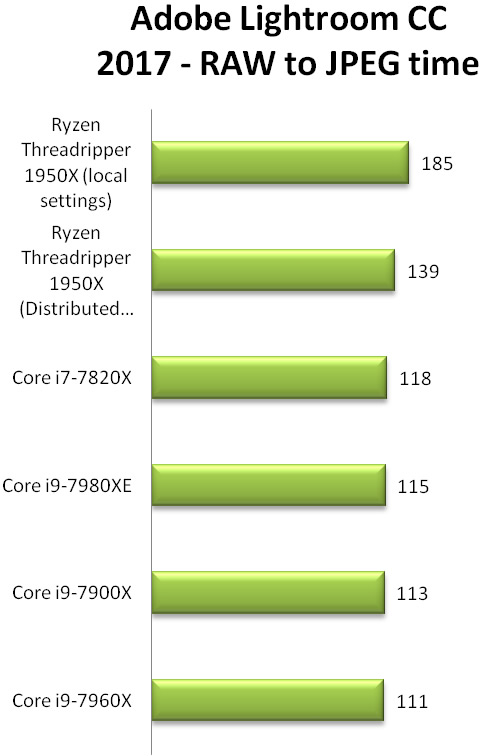
In Photoshop CC 2017 we ran a heavily loaded filter and color correction to the RAW data in batch processing. Once again the differences among the Intel chips were small, with the small lead of the new CPUs.

We used the Premiere Pro CC 2017 to measure the time needed to create a 4K movie from multiple videos.
Although the difference between the Core i9-7980XE and the Core i9-7960X is small, the Core i9-7960X was about 23% faster than the Core i9-7900X, and 36% fsatr than the to-Core i7-7820X.
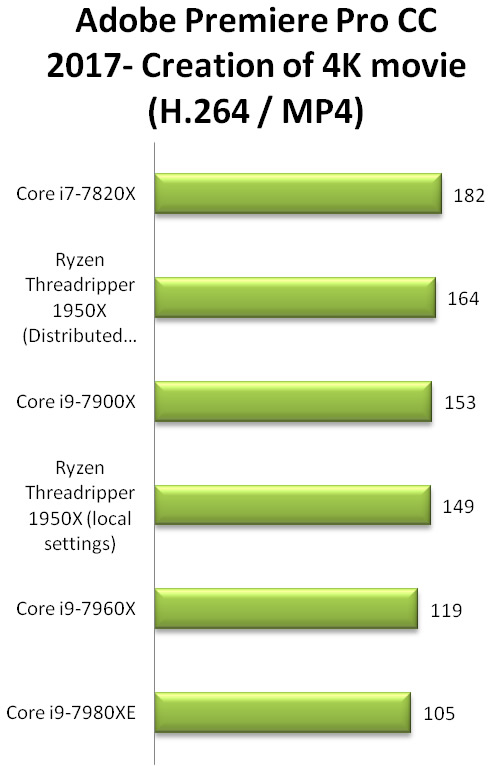
We also used the TMPGEnc Video Mastering Works 6 for the same task, in order to create a a full HD movie (H.265 / MKV).
The Core i9-7980XR was the fastest chip in the test, with the Core i9-7960X to follow closely. Notice that the overall performance of
the Ryzen Threadripper 1950X here was lower than the Skylake-X CPUs.

4. 3DMark Fire Strike / Time Spy
The 3DMark Fire Strike results aren't much of a surprise. This test is mostly GPU bound, so the Core i9-7980XE and Core i9-7960X's lower clocks relative to some of the other high-end Intel processors pulls their final scores down just a tad. Still, all for of these high-end platforms perform right in the same ballpark.
The Physics score of the Core i9-7960X was higher than the Core i9-7980XE's, although the two chips gave a similar Combined score.

The 3D Mark Time Spy becnhmark utilizes the DirectX 12.Again the new Core i9-7960X and the i9 Core i9-7980XE go side by side:

5. VRMark Orange Room, Ashes of the Singularity: Escalation
The VRMark's Orange Room becnhmark gave a good score to the Core i9-7900X and the Core i7-7820X. Obviously the specific benchmark is based on single-threaded performance and adding more cores does not make any difference.


We also measured the systems' performances with the Ashes of the Singularity: Escalation game at a resolution of 1,920 x 1,080 pixels and in DirectX 12 mode and the "Standard" quality settings.
Intel's models performed well here but the lead goes to the Core i9-7960X.

6. Power consumption, CPU temperature
Here we measured the power consumption of the entire PC system with each different CPU installed, during the CINEBENCH R15 / CPU and the Premiere Pro CC 2017 benchmarks.
Our goal was to give you an idea as to how much power each configuration used while idling at the Windows desktop and while under a heavy CPU workload. Keep in mind, this is total system power consumption being measured at the outlet with only the processor loaded and not the the individual power of the CPUs alone.
These power consumption numbers are very interesting. Though the Core i9-7980XE and Core i9-7960X have 60 - 80% more cores than the Core i9-7900X (18 and 16 cores vs. 10 cores), they consumed only about 30 more watts under load. Somehow the additional cores on the higher-end Core X-series processors do not push power consumption much higher. The i7-7960X had the higherst power consumption in the specific benchmarks and the Threadripper was more power efficient.
In terms of CPU temperature, the differences among all the processors of the tes were very small, with the Core i7-7900X to run a bit hotter.
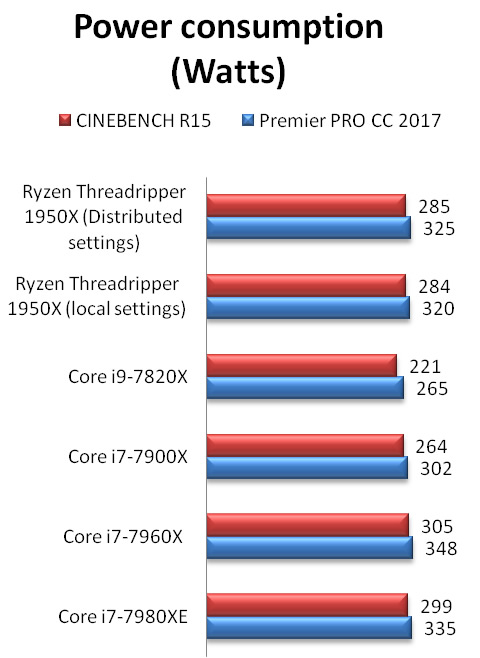

7. Final words
The test results showed that both the Intel Core i9-7980XE and Core i9-7960X are champrions in multi-threading. These two processors posted the highest scores we have seen to date in workloads like rendering, encoding, and file compression, and they also offer strong single-threaded performance, that outpaces AMD's Ryzen processors in most cases.
We were also impressed by the relatively low power consumption of the new chips. On the other hand, lightly-threaded workloads do not require all of the compute resources and bandwidth available with these ultra-high-end CPUs. This means that higher-clocked processors based on newer micro-architectures will just do the job, if not better.
Intel once again has the fastest slice of silicon on the market. But it seems that there's little justification for the price tag. The Threadripper 1950X features 16C/32T and costs $1,000. Intel's Core i9-7900X offers just 10C/20T for the same price. With the exception of gaming, the 1950X is a more powerful processor.
The i9-7960X costs a whopping $1,700 and while it might be faster, it certainly isn't $700 faster. The same applies for the $1,999 Core i9-7980XE.
Once again, are you willing to pay for the best performing silicon on the market or you go or for the Threadripper, which offers most of the performance at a fraction of the price?
